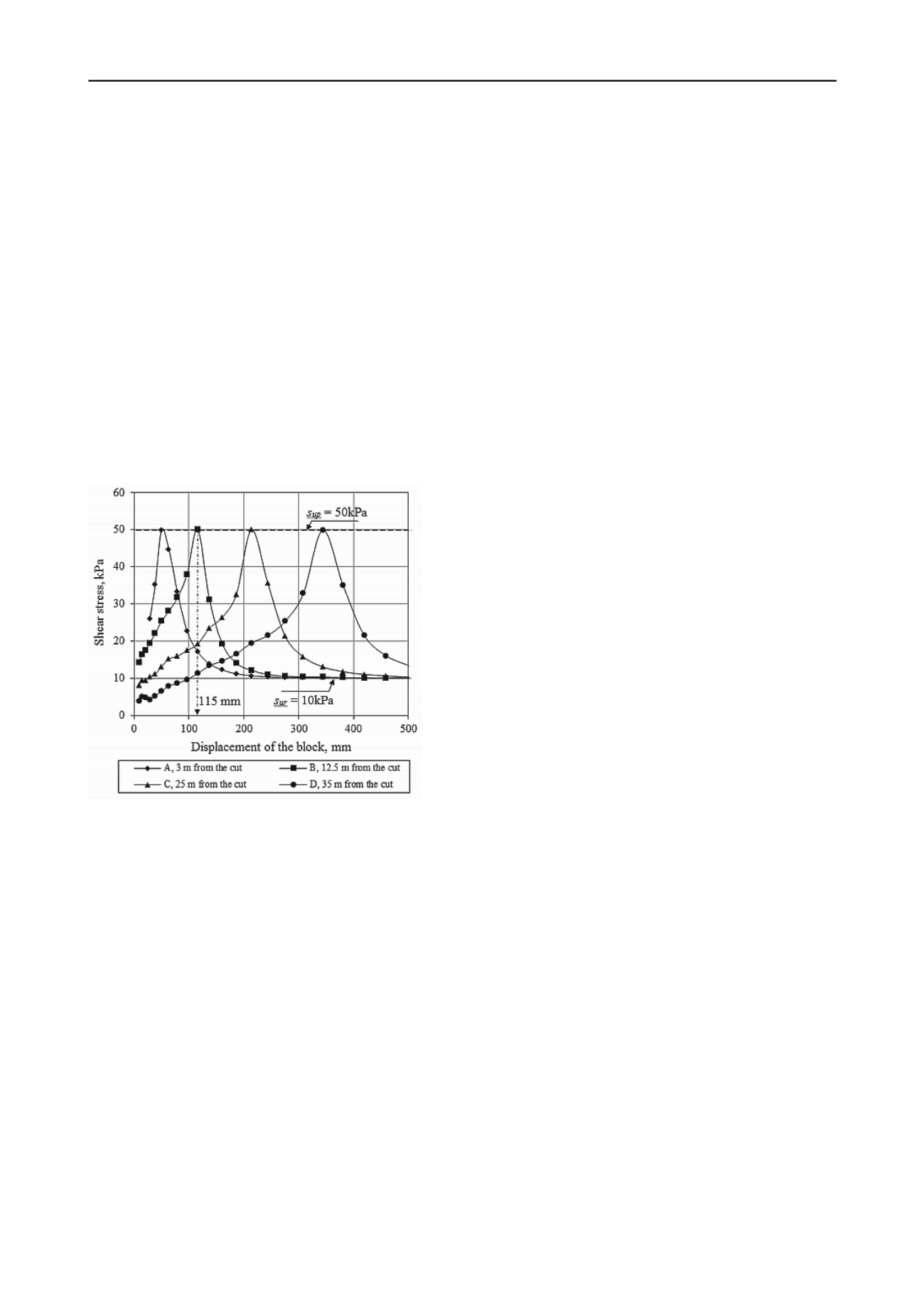
2180
Proceedings of the 18
th
International Conference on Soil Mechanics and Geotechnical Engineering, Paris 2013
strength of soil in the entire failure plane to the residual shear
strength and global failure will occur.
7. REFERENCES
Figure 4 shows the variation of shear stress at 4 different
locations A, B, C and D (Fig. 1) which are located from the
vertical face of the excavated/eroded block at horizontal
distance of 3 m, 12.5 m, 25 m and 35 m, respectively. Consider
the soil element B at 12.5 m distance. The shear stress in this
element is increasing with movement of the excavated/eroded
soil block. When the block is displaced by an amount of 115
mm, the shear stress in this element is reached to the peak shear
strength of the soil (50 kPa). However, at this displacement of
the block, the element A is almost at the residual shear strength.
On the other hand, the elements C and D are still in the pre-peak
state. That means the shear stress is gradually transferred to the
soil elements in the right with displacement of the
excavated/eroded soil block. For the soil element under the
slope of the river bank there is an initial shear stress. With
movement of the block the shear stress is increased from that
initial value. However, the initial shear stress is less in the
elements far from the river bank. Similar variation in shear
stress and mobilized shear strength are obtained for Case-I and
II.
Anderson L. and Jostad H.P. 2007. Numerical modeling of failure
mechanisms in sensitive soft clays — application to offshore
geohazards. Offshore Tech. Conf., Texas. Paper OTC 18650.
Bernander S. 2000. Progressive failure in long natural slopes:
formation, potential extension and configuration of finished slides
in strain-softening soils. Licentiate Thesis, Luleå University of
Technology.
Bjerrum L. 1967. Progressive failure in slopes in overconsolidated
plastic clay and clay shales. Terzaghi Lecture. J. of the Soil Mech.
and Found. Div., ASCE 93(5), 3-49.
Carson M.A. 1979. On the retrogression of landslides in sensitive
muddy sediments: Reply. Can. Geotech. J. 16(2), 431-444.
Cruden D.M. and Varnes D.J. 1996. Landslides types and processes. In
Landslides investigation and mitigation. Special Report 247.
Transportation Research Board, NRC. Edited by A.K. Turner and
R.L. Schuster. National Academy Press, Washington, D.C., 37-75.
Dey R., Hawlader B., Phillips R. and Soga K. 2012. Effects of shear
band propagation on submarine landslide. Proc. of the 22
nd
Int.
Offshore and Polar Engineering Conf., Rhodes, Greece,766- 773.
Einav I. and Randolph M.F. 2005. Combining upper bound and strain
path methods for evaluating penetration resistance. Int. J. Num.
Methods Engineering63(14), 1991-2016.
Grondin G. and Demers D. 1996. The Saint-Liguori flakeslide:
Characterization and remedial works. In Proc. of the 7th Int.
Symposium on Landslides, Trondheim, Norway, 2, 743-748.
Gregersen O. 1981. The quick clay landslide in Rissa, Norway. In Proc.
of the 10th Int. Conf. on Soil Mech. and Foundation Engineering,
Stockholm, Sweden. NGI, Publication No. 135, 421-426.
Karlsrud K., Aas G. and Gregersen O. 1984. Can we predict landslide
hazards in soft sensitive clays? Summary of Norwegian practice
and experiences. In Proc. of the 4th Int. Symposium on Landslides,
Toronto, Ont., 1, 107-130.
Leroueil S. 2001. Natural slopes and cuts: movement and failure
mechanisms. Géotechnique 51 (3), 197-243.
Locat A., Leroueil S., Bernander S., Demers D., Locat J. and Ouehb L.
2008. Study of a lateral spread failure in an eastern Canada clay
deposit in relation with progressive failure: the Saint-Barnabé-Nord
slide. In Proc. of the 4th Canadian Conf. on Geohazards: From
Causes to Management, Québec, Que., 89-96.
Locat A., Leroueil S., Bernander S., Demers D., Jostad H.P. and Ouehb
L. 2011. Progressive failures in eastern Canadian and Scandinavian
sensitive clays. Can. Geotech. J. 48 (11), 1696-1712.
NGI Report 2001. Effect of strain softening on stability analysis.
Analysis of retrogressive sliding due to strain softening-Ormen
Lange case study, Report No 521001 (10).
Figure 4. Variation of shear stress at four different locations from the
cut
Odenstad S. 1951. The landslide at Sköttorp on the Lidan River,
February 2, 1946. Royal Swedish Institute Proceedings 4, 1-38.
Quinn P., Diederichs M.S., Hutchinson D.J. and Rowe R.K. 2007. An
exploration of the mechanics of retrogressive landslides in sensitive
clay. In Proc. of the 60th Canadian Geotechnical Conf., Ottawa,
Ontario, 721-727.
5. CONCLUSION
This paper presents a new numerical approach to model the
initiation and propagation of shear band in upward progressive
failure as encountered near the river banks. Toe erosion is
considered as the triggering factor. Coupled Eulerian-
Lagrangian (CEL) approach currently available in ABAQUS FE
software is used for numerical analysis. Nonlinear strain
softening behavior of sensitive clay is incorporated in this large
deformation finite element analysis. Three cases are analyzed in
this study. In Cases I and II global failure is occurred. However,
in Case-III, although global failure is not occurred, the shear
band propagation reduced the shear strength in the potential
failure plane significantly over a large distance and the slope
might be marginally stable for further loading.
Quinn P. 2009. Large Landslides in Sensitive Clay in Eastern Canada
and the Associated Hazard and Risk to Linear Infrastructure.
Doctoral thesis, Queen's University.
Tavenas F., Flon P., Leroueil S. and Lebuis J. 1983. Remolding energy
and risk of slide retrogression in sensitive clays. Proc. of the
Symposium on Slopes on Soft Clays, Linköping, Sweden, SGI
Report No. 17, 423-454.
Tavenas F. 1984. Landslides in Canadian sensitive clays — a state-of
the-art. In Proc. of the 4th Int. Symposium on Landslides, Toronto,
Ont., 1, 141-153.
6. ACKNOWLEDGEMENTS
The writers would like to acknowledge the financial support
from Research & Development Corporation of Newfoundland
and Labrador and C-CORE.


